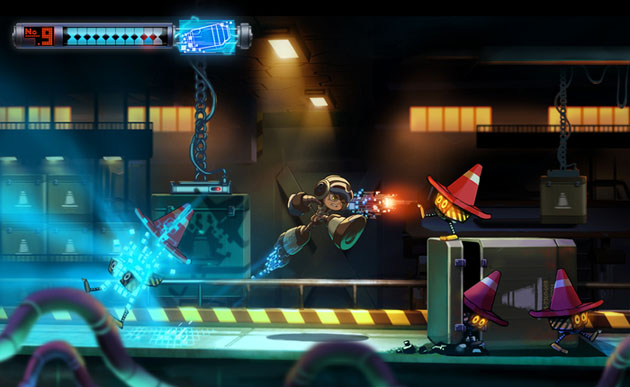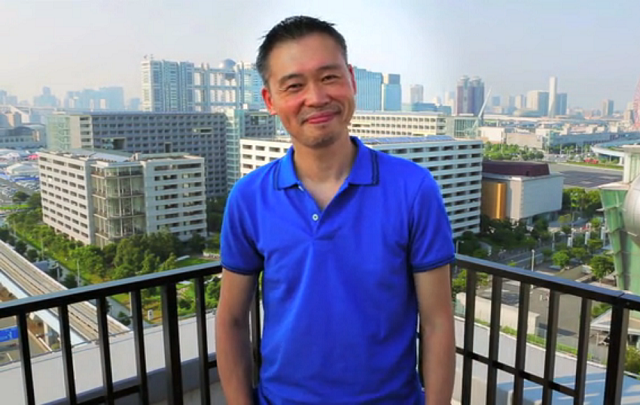This post has not been edited by the GamesBeat staff. Opinions by GamesBeat community writers do not necessarily reflect those of the staff.
Keiji Inafune has an idea for a game, but he needs your help to make it happen. That’s why he’s launched a Kickstarter for the new 2D action side-scroller he’s developing called Mighty No. 9. Within the first couple of days, the project breezily surpassed its funding goal of $900,000. Currently, it’s raised more than $1.9 million, and with that, has blown through several stretch goals.
As Joystiq noted, this is a “‘take my money!’ situation if there ever was one.” Fans who have been clamoring for a new Mega Man game have been disappointed by Capcom. As a result, Inafune is taking the opportunity to capitalize on his previous employer’s inaction and crowdfund the Blue Bomber’s spiritual successor.
But despite the adulation from longtime fans (including myself), this recent news from Inafune raises several questions and deserves more than a little scrutiny. After all, what does it say about Japanese video game development that one of its most outspoken critics is now eschewing his earlier statements in favor of a “return to our roots” approach with his latest project? And just what exactly are Inafune’s supporters actually throwing their money at when they donate $20 toward the completion of Mighty No. 9?
 It’s been nearly four years since Inafune reflected on 2009’s Tokyo Game Show and said, “Japan is over. We’re done. Our game industry is finished.” In an interview with The New York Times one year later, Inafune elaborated on what he meant, explaining that, “I look around T.G.S., and everyone’s making awful games. Japan is at least five years behind. It’s like we’re still making games for the last generation of game consoles. Capcom is barely keeping up. The ideas, gameplay, design — there’s no diversity, no originality.”
It’s been nearly four years since Inafune reflected on 2009’s Tokyo Game Show and said, “Japan is over. We’re done. Our game industry is finished.” In an interview with The New York Times one year later, Inafune elaborated on what he meant, explaining that, “I look around T.G.S., and everyone’s making awful games. Japan is at least five years behind. It’s like we’re still making games for the last generation of game consoles. Capcom is barely keeping up. The ideas, gameplay, design — there’s no diversity, no originality.”
So why is that exactly what Inafune has decided to do now with Mighty No. 9? After years of berating Japanese developers for refusing to explore new genres and game systems, Inafune is ignoring his own criticisms. Rather than create a new intellectual property, the acclaimed designer has settled for remaking a decades-old character in the well-worn tradition of 2D side-scrolling action games.
The project’s Kickstarter page attempts to address this contradiction, claiming that Mighty No. 9 is an example of Inafune putting his money (or more accurately, yours) where his mouth is. It claims the new game is a testament to working “with the West” and “embracing new ways of doing things in order to appeal to not just Japanese fans but overseas gamers as well.” But Kickstarter appears to be the extent of these “new ways,” with the FAQ section citing nothing that demonstrates how Mighty No. 9 marks a striking departure from other IPs being developed in Japan.
Inafune even openly refers to Mighty No. 9 as “classic Japanese.” So what should fans, potential backers, and the rest of the public make of this silent reversal? As recently as a year ago and up through this past spring, Inafune has argued that Japanese game development has been slow to globalize and remains on life support. Does that mean we should think of Mighty No. 9 as just the latest in a long line of Japanese games that refuses to evolve and appeal to audiences all over the world? Is it a failure of the imagination and the larger Japanese development culture?
Hardly.
Instead, Inafune’s latest project is a tacit admission that the situation is a bit more complex than he originally let on. It’s an acknowledgement that simply trying to appeal to Western audiences and experiment for the sake of experimentation aren’t values in and of themselves. Mighty No. 9 goes against everything Inafune has previously argued, yet it clearly has many of the qualities that make for a great game: a clear and inspired vision; a dedicated, passionate, and experienced team; and a proven track record.
By collaborating with Inti Creates on a spiritual successor to a series that almost defines the genre, Inafune has brought together many of the ingredients for a nearly ideal Kickstarter.
That said, there are still plenty of reasons to be skeptical of Mighty No. 9.
Potential problems
Inafune’s apparent backtracking aside, the project is still in its early stages. Unlike FTL: Faster Than Light and similar Kickstarted projects, Mighty No. 9 is nowhere near completion. Inafune and his team aren’t just asking for the resources to expand and complete their game but also for supporters to take a risk funding a project that still exists mostly on paper.
 Any number of obstacles could thwart the game’s on-time and on-budget development — not least of all the potential legal disputes that could follow from Mighty No. 9’s uncanny similarity to Capcom’s Mega Man.
Any number of obstacles could thwart the game’s on-time and on-budget development — not least of all the potential legal disputes that could follow from Mighty No. 9’s uncanny similarity to Capcom’s Mega Man.
Inafune was mostly dismissive of concerns over legality during an interview with U.S. Gamer, saying that, “If the idea is that I should try to stop creating characters via my style and try to create a different style that totally doesn’t fit with me, that doesn’t seem to make a lot of logical sense. Certainly I’m not going to do that just to make Capcom happy.”
While the designer tried to put a positive spin on the topic, what he failed to mention was whether the studios working on the project have already consulted with lawyers to see what kind of legal footing the project currently stands on. Perhaps Capcom won’t move aggressively to squash the project for fear of a PR backlash. Or maybe it will, in which case that $1.9 million Mighty No. 9 has already raised could be eaten up in court and lawyer fees alone.
As with any Kickstarter, there’s alway the possibility that the project will be plagued by setbacks and insufficient funding. Both Harebrained Schemes’ Shadowrun Returns and Replay Games’ Leisure Suit Larry: Reloaded shipped late. The now infamous Broken Age (formerly Double Fine Adventure) still remains in development, and Double Fine will use a pared-down, “early release” version of the game to garner extra funds to complete the project.
 While Inafune and his team are aiming for an 18-month development schedule, it could easily take longer, and neither Inti Creates nor Comcept has the resources to sustain development for any length of time in the absence of an established publisher.
While Inafune and his team are aiming for an 18-month development schedule, it could easily take longer, and neither Inti Creates nor Comcept has the resources to sustain development for any length of time in the absence of an established publisher.
This doesn’t mean that Mighty No. 9 is a bad project or that Inafune shouldn’t try to bring it to fruition. But anyone interested in backing the project should be mindful of the unique risks surrounding it and what its existence implies about Inafune’s previous criticisms of Japanese video games. If only they’d known that what the creator of Mega Man was calling for was a return to “roots” — an attempt to reinvest in the genres and series that first made Japanese developers famous — I’m sure they’d have been happy to oblige.


